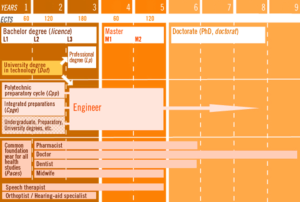
In France, Higher Education is a double-component system: universities (“Université”) and Higher Schools (“Grandes Ecoles”) which offer scientific and management curricula. This system is inherited from the political and economic history of our country.
The “Baccalauréat” (final examination at the end of secondary studies for which the candidates are about 18 years old) is necessary to be admitted to university to follow a standard program (Bachelor-Master-Doctorate).
Students passing the “Baccalauréat” who want to enter the “Grandes Ecoles” have to follow a particular preparation during two years, the so called “Classes Préparatoires aux Grandes Ecoles (CPGE)”, in order to be able to sit for a highly selective competition to the “Grandes Ecoles”.
Access to the CPGE classes is organized through a national procedure after which only the 20% top candidates are admitted. During the CPGE cycle, the students attend intensive courses (small class size and regular assessment) mainly in mathematics, physics, chemistry and natural sciences (biology and geology) and leads to the validation of 120 ECTS.
After the completion of the CPGE classes, the successive students need to sit again for an entry competition in order to be admitted to one of the “Grandes Ecoles”. Those admitted to the ENSG can be hence considered as being part of the top 10% potential students in geosciences throughout France.
After entering the “Grandes Ecoles”, students fellow a 3-year curriculum leading to the validation of 180 additional ECTS (accumulation of 300 ECTS) and to the graduation as “Ingénieur” that confers to the graduate the European Master’s Degree. The curriculum is dedicated to scientific and technical subjects as well as to social, economic and management skills. All of the graduated students achieve:
– English language level B2 according to the European Framework of Reference for Languages;
– At least 28 weeks of internship in the industry and/or research centers;
– A research training period.
Since 1934, the “Grandes Ecoles” have to be accredited to graduate the “Ingénieur” students by a national ad hoc commission: “Commission des Titres d’Ingénieur (CTI)”, (http://www.cti-commission.fr/) .
The academic programme at ENSG is organised into semesters worth 30 ECTS each, totalling 180 ECTS for the complete course. Added to the 120 ECTS obtained prior to entry to ENSG, the diplôme d’Ingénieur ENSG therefore corresponds to 300 ECTS, i.e. a Masters degree.
An Ingénieur of the Ecole Nationale Supérieure de Géologie is therefore someone who has obtained the national diplôme d’Ingénieur, which corresponds to 5 years of study at higher education level. They have completed an introduction into, and by, research. For this reason, the university grade of “Master” is now conferred on all French “Ingénieurs”. This distinction is stated on the degree certificate.
The BMD system: Bachelor – Master – Doctorate
As part of the construction of higher education in the European region, the teaching at universities was reorganized according to the “Bachelor – Master – Doctorate plan (BMD)” which is defined by the Bologna process (19th June 1999).
The BMD system provides equivalences within the international education system, divided into three levels:
- bachelor’s degree
- master’s degree
- doctorate
The BMD system is based on the number of semesters completed after secondary school and their equivalent with respect to in European credits in the ECTS system:
- Bachelor = 6 semesters = 180 ECTS*
- Master = 10 semesters = 300 ECTS
- Doctorate = 16 semesters
The European Credits Transfer System (ECTS)
Is a learner-centered system for credit accumulation and transfer based on the transparency of learning outcomes and learning processes.
It aims at facilitating the planning, delivery, evaluation, recognition and validation of qualifications and units of learning as well as student mobility. ECTS is widely used in formal higher education and can be applied to other lifelong learning activities.
More

